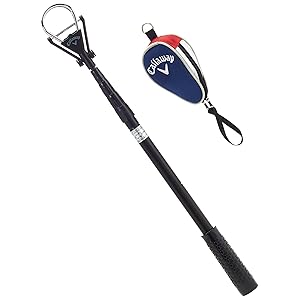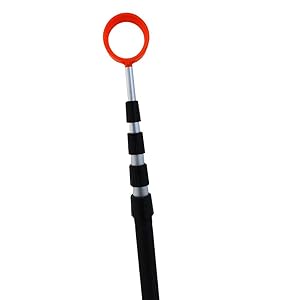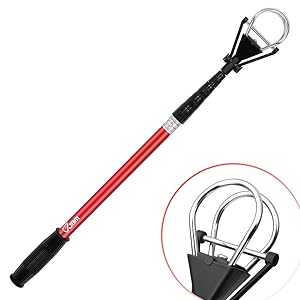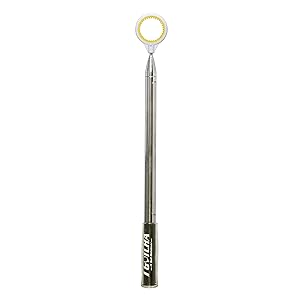Losing golf balls kinda sucks. By now, like myself and many others, you’re most likely resigned to accepting that, once out of sight, they’ll never be seen again. Good golf balls aren’t exactly cheap these days, and beginner to mid-handicap players will lose golf balls for more often than those at the top of their game. It’s infuriating, but is it worth reaching that extra few inches into the water and risking ruining your day? No, not at all.
Extendable golf ball retrievers have been around a while now, in days of old they were quite flimsy, hard to use, and rarely worth the hassle; all that has since changed. You can pick up one of the best golf ball retrievers on the market for around the same price as a pack of ten premium golf balls. Meaning that if it rescues just ten golf balls for you in the course of your entire golfing career, it’ll have paid for itself.
The Best Golf Ball Retrievers

What makes for a good ball retriever? What sets the best retrievers apart from the cheap and nasty ones? We’ll get to all that in just a minute. First up, we’ve done the hard work of scouring through and testing some of the most popular golf ball retrievers around today to pick out the leaders. Below are the best golf ball retrievers for retrieving lost golf balls from thick woods and water hazards with ease.
Callaway Golf Ball Retriever
The Callaway Extending Golf Ball Retriever is the closest to a “must-have” retriever we’ve ever tried. Its stainless steel retriever mechanism is super easy to use even at stretching distance thanks to an ergonomic grip which keeps it steady in your hands.
A little on the heavy side compared to cheaper counterparts, though the weight is the tradeoff for a high build-quality extender that is sure to last.
Available in 15′ or 6′ sizes, both come with a stylish zip headcover that looks right at home in your bag with your other clubs; unlike most other retrievers, it really looks the part. Worth the extra few dollars compared to inferior brands and is sure to pay for itself in no time.
IGOTCHA Executive Golf Ball Retriever
IGOTCHA makes a range of golf ball retrievers with varying heads and extension lengths. For us though, the Executive Retriever model is the best all-round option. It extends 10 feet in total and promises a reach of up to 14 feet, which in our experience is plenty and makes the extra cost for the additional 4-foot reach of the “Ultimate Retriever” unjustifiable.
It wins huge praise for being seemingly impossibly light (weighing just 8 ounces!) given the sturdiness at range. It’s IGOTCHAs best selling model and it isn’t hard to see why. The spring-loaded mechanism feels as though it’s built to last, and does a great job of picking out golf balls in the trickiest of situations.
JP Lann Orange Cap Golf Ball Retriever
The JP Lann retriever range offers arguably the most amount of flexibility. With 6, 9, 12, 15 and 18-foot sizes available with either an orange pressure cup head or a metal hinge, there’s undoubtedly something to fit every scenario. In our opinion, the 9-foot orange pressure cup is the happiest medium, with the shaft losing sturdiness quickly as you progress through the longer models.
The orange cup is what sets this apart from the others on our list. In muddy or dark water hazards it can be difficult to maneuver your way around the ball to retrieve it. The fluorescent orange cup makes this maneuvering effortless and seems to do as good a job of collecting the ball as the more complicated spring-based mechanisms.
JBM 6ft Golf Ball Retriever
JBM International’s golf ball sniffer retriever features one of the sturdiest frames around while being one of the most competitively priced. It makes short work of collecting golf balls, too.
At 6 foot in length, it’s one of the shorter models, but benefits from this by being incredibly compact and robust at full stretch. Besides, how often are you retrieving a golf ball more than six foot and an arms-length away? Very rarely.
IGOTCHA JAWZ Golf Ball Retriever
The JAWZ golf ball retriever by IGOTCHA is one of our favorites available for its fun looking and super effective head grip. We’ve seen golfers who struggled to maneuver the other more traditional head designs describe this as an absolute blessing. You position it around the ball, lightly press, and voila; the grip does the rest.
Our one suggestion for golfers looking to purchase is to opt for a model that’s slightly longer than you require to avoid having to extend the smallest sections. The smaller sections don’t tend to offer much sturdiness and can make placement quite difficult especially in thick woods or brambles.
Golf Ball Retrievers: What To Look For

Most of the best golf ball retrievers listed here are pretty intuitive to use. Some excel in soft ground, while others are far better underwater, or on hard surfaces. It’s impossible to know what scenario you’ll require a golf ball retriever in, so choosing one that performs well in most conditions is crucial.
Retriever head cap mechanisms
Securing the ball is your only aim, so a head cap that does this as effortlessly as possible should be at the top of your features list.
While many make use of a “press and capture” style mechanism, there are other options. Some come with spring-loaded capture mechanisms that are operated either automatically upon pressing, or via a trigger on the handle. In all honesty, we’d steer clear of these. They’re prone to breaking, rendering the entire retriever useless.
Of all the good retrievers we’ve tried over the years, circular grip style head caps seem to be the most consistent in capturing the ball regardless of the surroundings. They’re also simple to use and extremely durable.
Retriever shaft strength and material
Most golf ball retrievers are made from an aluminum shaft, as it offers reasonable strength while remaining light and easy to operate. Ideally, any telescopic golf ball retriever you choose should have reinforced joints, either through an extra layer of aluminum or better still: stainless steel.
Stainless steel is heavy but extremely durable and as such is often only used on the head of golf ball retrievers. A little weight on the head of the retriever makes it much easier to maneuver and distance, and since it’s the part of the retriever that gets the most wear, the durability is essential here.
Extension and total reach

It’s safe to wager that upwards of 9 foot in reach is excessive for most golfers. Sometimes, it’s better to just give up on a golf ball. Anything over 9 foot away in water is often nigh on impossible to fish out without much frustration.
Long golf ball retrievers will weigh more, retract less, and be more difficult to steer at distance. We’d stick to short to medium length retrievers that offer a convenient way to rescue all the golf balls that are just out of reach, but not difficult to get at.
Cost and value for money
The cheapest golf ball retriever isn’t going to be the best; that’s true of anything. Upmarket, high-quality ball retrievers cost a pretty penny more than some of the budget options but are almost always worth the investment.
A top quality retriever is going to last a long time and save you money on golf balls in the long run. If you weigh up the price of your golf balls with how frequently you lose them, you’ll find that it won’t be long until the extra few dozen dollars the top brand retrievers cost is covered.
Conclusion
To put it bluntly, avoid cheap models that aren’t likely to last a year, let alone a lifetime on the course.
Prefer golf ball retrievers with reinforced telescopic joints and stainless steel mechanisms if you intend to use them in water.
Remember that bigger isn’t always better and take portability and maneuverability into account before purchasing an enormous golf ball retriever that you’ll never get the full benefit from.
Choose from the brands we’ve highlighted in this guide to avoid disappointment. They’re all extremely capable of saving your golf balls from a life in the drink.





